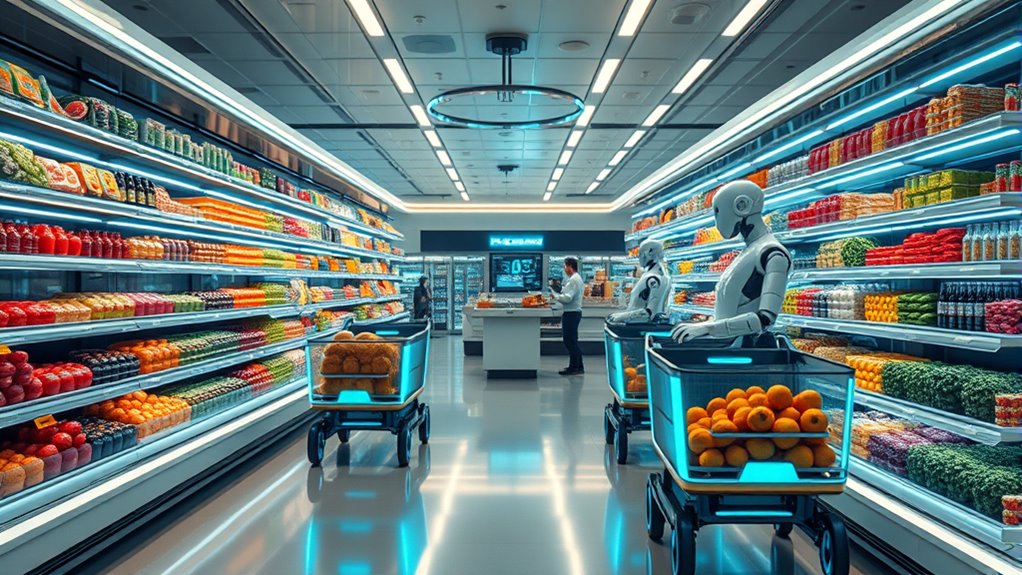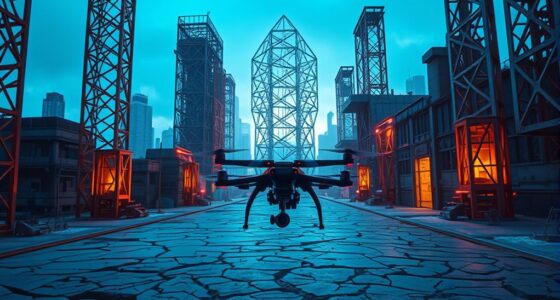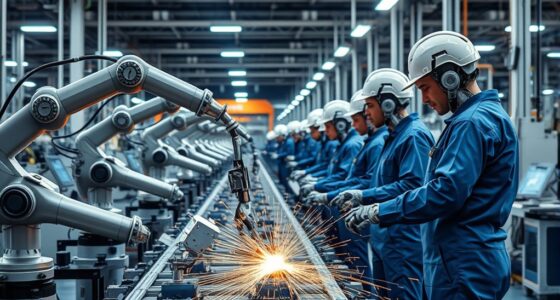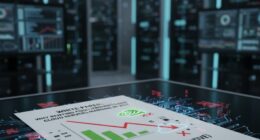The coming era of autonomous shopping networks means you’ll experience stores that operate without human staff, letting you walk in, pick items, and leave seamlessly. Advanced sensors, AI, and digital payments track your purchases instantly, eliminating checkout lines. These systems lower costs for retailers and offer you quicker, personalized shopping. As technology advances, you’ll see safer, more efficient environments—if you’re curious about how these innovations are shaping the future, there’s plenty more to explore.
Key Takeaways
- Autonomous shopping networks enable fully automated retail environments with seamless entry, real-time inventory tracking, and automatic billing.
- Advanced sensor fusion and AI technologies allow for accurate customer behavior interpretation and theft prevention.
- These systems significantly reduce checkout times, enhance personalization, and improve overall shopping convenience.
- Retailers benefit from lower labor costs, improved inventory management, and dynamic pricing capabilities.
- Challenges include security risks, sensor reliability, and system disruptions, requiring ongoing technological advancements.
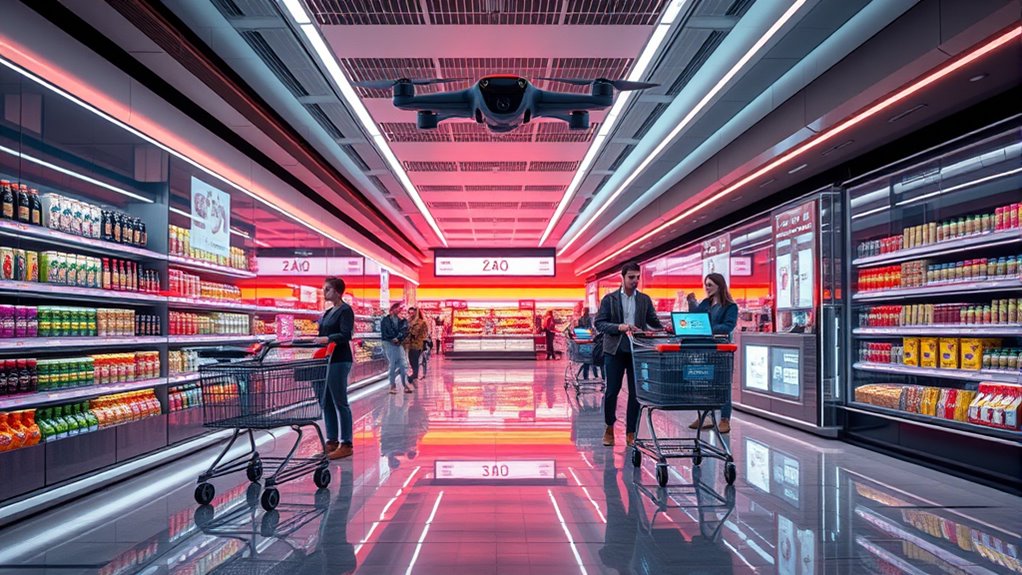
Have you ever wondered what shopping would look like if stores operated entirely without human staff? With autonomous shopping networks, that scenario becomes a reality. These fully automated retail environments minimize or eliminate human involvement. You simply enter through specialized apps or payment cards, browse the shelves, pick out what you want, and walk out. Your purchases are detected through advanced sensor systems—cameras, RFID tags, weight sensors, and IoT devices—that track your movements and product choices in real time. Once you leave, the system automatically charges your account, making the whole process seamless and queue-free. This setup offers a frictionless, grab-and-go experience that differs from traditional self-checkouts, which still require manual scanning, or scan-and-go systems, where you scan items yourself. Autonomous networks create a truly automated shopping environment, removing manual steps and reducing wait times considerably. These systems rely on high-speed data processing and reliable connectivity to function smoothly. The backbone of this innovation lies in key technologies. Sensor fusion combines AI-powered cameras, weight sensors, RFID, and computer vision to detect when you pick up or return items. Artificial Intelligence processes this data to interpret your behavior, manage inventory, and prevent theft or fraud. These AI systems operate independently, handling multiple retail functions—from restocking shelves to engaging with you digitally—without human intervention. Digital payment systems are integrated seamlessly, automatically charging your account as you exit, removing the need for manual checkout lines. All these components communicate through cloud-based data centers, which coordinate real-time operations across the entire network, ensuring accuracy and efficiency. Additionally, reliable network infrastructure is essential to support continuous operation and real-time data transmission.
This shift benefits you as a customer by drastically reducing checkout times and simplifying your shopping experience. You can grab what you want and walk out, enjoying a fast, convenient process that aligns with the online shopping convenience you’ve grown accustomed to. Personalization is also enhanced as AI analyzes your buying patterns, offering tailored suggestions and promotions. For retailers, the advantages are just as compelling. Labor costs drop since fewer staff are needed for checkout counters. Inventory management improves with predictive analytics, reducing stockouts and overstock issues. Dynamic pricing adjusts automatically based on demand, maximizing revenue. The robust digital infrastructure also makes the system adaptable, future-proofing the retail model.
However, challenges remain. Security concerns, like theft and fraud, increase without human oversight, necessitating sophisticated detection systems. Technological failures, such as sensor glitches or network outages, could disrupt operations. Despite these hurdles, autonomous shopping networks are poised to redefine retail, offering an innovative, efficient, and customer-centric shopping experience.
Frequently Asked Questions
How Will Autonomous Shopping Networks Impact Local Small Businesses?
Autonomous shopping networks will boost your small business by reducing operational costs, streamlining inventory management, and enhancing customer personalization. You’ll gain real-time data insights to optimize marketing and increase revenue. However, you’ll need to navigate challenges like data privacy, initial costs, and regulatory compliance. Embracing these technologies can help you stay competitive, expand your reach, and serve your community better, but staying adaptable is key to overcoming potential disruptions.
What Privacy Concerns Are Associated With Autonomous Shopping Networks?
Your privacy feels like a fragile glass house shattering under endless watchful eyes. Autonomous shopping networks collect deep personal data—demographics, behaviors, even biometric info—without clear consent, risking exposure and misuse. Constant surveillance from cameras and sensors feels invasive, stripping away your sense of freedom. As your data is mined, aggregated, and targeted, you risk losing control over your own choices, leaving you vulnerable to manipulation and privacy breaches.
How Secure Are Transactions Within Autonomous Shopping Networks?
Your transactions in autonomous shopping networks are quite secure, thanks to advanced measures like encryption, tokenization, and multi-factor authentication. These technologies protect your payment data and verify your identity, reducing fraud risks. Additionally, blockchain ensures transparency and tamper resistance, while AI-driven fraud detection monitors activity in real-time. Partnering with secure cloud platforms and following industry standards like PCI DSS further fortifies transaction security, giving you peace of mind.
What Regulations Might Govern the Use of Autonomous Shopping Networks?
You’ll see regulations focusing on data privacy, requiring transparency about how your biometric and transaction data are collected and stored. Liability laws will clarify who’s responsible if errors or fraud occur. Payment security standards like PCI DSS will mandate strong authentication and encryption. Additionally, rules will guarantee fair practices, dispute resolution, and compliance with KYC and AML laws, all aiming to protect your interests and ensure trustworthy autonomous shopping experiences.
How Will Employment in Retail Change Due to Autonomous Shopping Networks?
You’ll see retail jobs shift markedly, with many cashier and checkout roles disappearing as autonomous shopping networks automate tasks. Instead, you’ll need skills in managing AI systems, maintaining sensors, and analyzing data. While some positions may be reduced, new roles in supervision, tech support, and customer service will emerge. Overall, employment will become more specialized, requiring ongoing learning, but the total workforce size may decrease, impacting job availability for entry-level workers.
Conclusion
As you step into this new era, autonomous shopping networks become the pulse of your daily life, seamlessly weaving convenience into every task. They’re like a trusted compass guiding you through a maze of choices, making shopping effortless and intuitive. Embrace this change, for it’s not just about technology; it’s the dawn of a smarter, more connected world where your needs are anticipated before you even voice them. The future is yours to navigate—smoothly and confidently.
